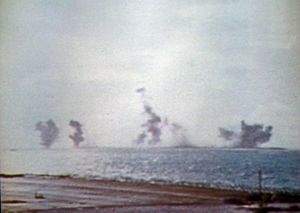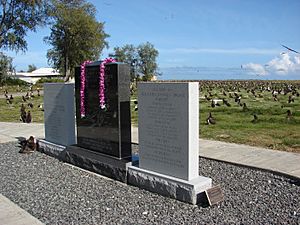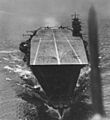Battle of Midway facts for kids
Quick facts for kids Battle of Midway |
|||||||
|---|---|---|---|---|---|---|---|
| Part of the Pacific Theater of World War II | |||||||
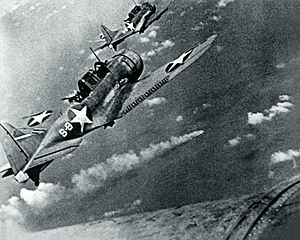 U.S. Douglas SBD-3 Dauntless dive bombers from the USS Hornet about to attack the burning Japanese cruiser Mikuma for the third time on 6 June 1942. |
|||||||
|
|||||||
| Belligerents | |||||||
| Commanders and leaders | |||||||
| Nimitz Fletcher Spruance Buckmaster Murray |
Yamamoto Kondo Nagumo Yamaguchi † Yanagimoto † |
||||||
| Strength | |||||||
| 3 carriers ~25 support ships 233 carrier aircraft 127 land-based aircraft |
4 carriers 2 battleships ~15 support ships (heavy and light cruisers, destroyers) 248p90 carrier aircraft, 16 floatplanes Did not participate in battle: 2 light carriers 5 battleships ~41 support ships (Yamamoto "Main Body", Kondo "Strike Force" plus "Escort" and "Occupation Support Force") |
||||||
| Casualties and losses | |||||||
| 1 carrier sunk 1 destroyer sunk 150 aircraft destroyed 307 killed |
4 carriers sunk, 1 cruiser sunk 248 carrier aircraft destroyedp524 3,057 killed |
||||||
The Battle of Midway was an important naval battle of World War II, between the United States and the Empire of Japan. It took place from 4 June 1942 to 7 June 1942. This was about a month after the Battle of the Coral Sea, and six months after the Japanese attack on Pearl Harbor.
The United States Navy defeated a Japanese attack against Midway Atoll (northwest of Hawaii) and destroyed four Japanese aircraft carriers and a heavy cruiser.
The battle was a decisive victory for the Americans. It was the most important naval battle of the Pacific area in World War II. The battle weakened the Imperial Japanese Navy for the rest of the war. Japan could not build up its forces again. The United States replaced their lost ships and planes with better ones very quickly. Japan could only make a few poor quality replacements.
The Japanese planned to bring America's carriers into a trap and sink them. The Japanese also tried to take Midway Atoll to build defenses far from their homeland and prepare to invade Fiji, Samoa, and Hawaii.
The Midway operation, like the attack on Pearl Harbor, was made to destroy the American strength in the Pacific Ocean. This way, Japan could become the biggest power in the area and unify Asia under its control. It was also hoped that another defeat would force the U.S. to ask for peace soon.
After the defeat, Imperial Japanese Navy forces retired. Japan lost four out of their six carriers, and hundreds of their best air pilots. This stopped the expansion of the Japanese Empire in the Pacific, and the Americans began to slowly advance towards Japan.
Contents
Why was Midway important?
Midway Island was very important for a few reasons:
- Strategic Location: Midway was located in the middle of the Pacific Ocean. It was a crucial spot for the U.S. military because it had an airfield. From there, planes could fly to other important places in the Pacific.
- Protecting Hawaii: If Japan had taken Midway, they could have used it as a base to attack Hawaii and even the mainland United States.
- Breaking the Japanese Advance: The U.S. victory at Midway stopped Japan from taking more territory in the Pacific. It was a turning point in the war.
Background
After attacking Pearl Harbor in December 1941, Japan had many victories in the Pacific. They captured islands and territories quickly. Japan wanted to take Midway Island to:
- Expand Territory to get more control in the Pacific.
- Trick the U.S. Navy into a battle where they could destroy the American fleet.
- Create a strong efensive line to protect their newly won territories.
The United States knew that Japan was planning something big. American codebreakers had figured out some of Japan's secret messages. This gave the U.S. Navy important information:
- The U.S. knew that Midway was Japan's target.
- The U.S. Navy prepared a trap for the Japanese fleet. They sent their aircraft carriers to wait near Midway.
The Battle (4–7 June 1942)
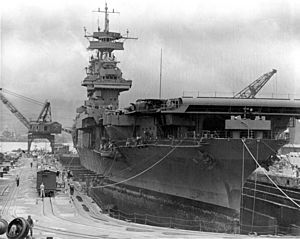
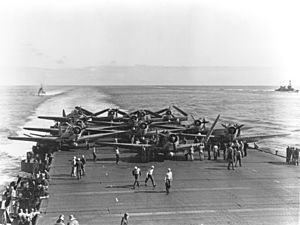
Early in the morning on June 4, 1942, Japanese planes attacked Midway Island. They bombed the airfield and tried to destroy the U.S. defenses. U.S. planes took off from Midway and the American aircraft carriers to attack the Japanese fleet.
Torpedo Attacks: U.S. torpedo planes attacked the Japanese carriers. These attacks didn't do much damage, but they distracted the Japanese.
While the Japanese were busy dealing with the torpedo planes, U.S. dive bombers attacked. They hit four Japanese aircraft carriers:
- Akagi
- Kaga
- Sōryū
- Hiryū
These attacks were very successful. The dive bombers dropped bombs that caused big explosions and fires on the Japanese carriers.
The battle continued for several days. The Japanese launched more attacks, but the U.S. Navy fought back strongly. The last Japanese carrier, Hiryū, was also sunk by U.S. planes. With all four of their aircraft carriers destroyed, the Japanese were forced to retreat.
Important people
- Chester W. Nimitz: He was the commander of the U.S. Pacific Fleet. He made important decisions that helped the U.S. win the battle.
- Isoroku Yamamoto: He was the commander of the Japanese fleet. He planned the attack on Midway, but his plan didn't work out.
- Codebreakers: These were the people who figured out Japan's secret messages. Their work was very important because it gave the U.S. Navy the information they needed to prepare for the battle.
Why was the Battle of Midway a turning point?
The Battle of Midway was a turning point in the Pacific War because:
- It stopped Japan from taking more territory in the Pacific.
- Japan lost four of its best aircraft carriers. This made it harder for them to launch attacks and defend their territory.
- The victory at Midway gave the U.S. a big boost in morale. It showed that the U.S. could beat Japan.
- After Midway, the United States was able to go on the offensive. They started to win back territory from Japan.
Aftermath
After the Battle of Midway the United States began to attack Japanese-held islands. This was called the island-hopping campaign.
The war in the Pacific continued for several more years. There were many more battles and a lot of fighting. Japan eventually surrendered in August 1945, after the U.S. dropped atomic bombs on Hiroshima and Nagasaki.
Interesting facts about the Battle of Midway
- The battle was a turning point for the war in the Pacific in World War II. It was the first major defeat for Japan.
- Codebreaking the plans of the Japanese was a huge factor in result of the battle. The Americans knew when they were coming and what ships and planes they were coming with.
- The American ships were also equipped with radar that allowed them to be one step ahead of the Japanese.
- The American planes were the most important part of the battle as they sank all of the Japanese aircraft carriers.
- America had 300 casualties and the Japanese had 3000!
- Commander John Ford, who was also a Hollywood movie director filmed the Japanese attack on Midway from the power plant of Sand Island and was wounded in the arm.
- Today, Midway Atoll is a National Wildlife Refuge. It is home to many birds and other animals. People can visit Midway to learn about the battle and see the wildlife.
Images for kids
-
Torpedo bomber Martin B-26 Marauder "Susie-Q" of the 18th Reconnaissance Squadron, 22nd Bombardment Group, USAAF, was flown by 1/Lt James Perry Muri during the Battle of Midway on 4 June 1942
-
This SBD-2 was one of sixteen dive bombers of VMSB-241 launched from Midway on the morning of 4 June. Holed 219 times in the attack on the carrier Hiryū, it survives today at the National Naval Aviation Museum at Pensacola, Florida.
-
Akagi, the flagship of the Japanese carrier striking force which attacked Pearl Harbor, as well as Darwin, Rabaul, and Colombo, in April 1942 prior to the battle.
-
Ensign George Gay (right), sole survivor of VT-8's TBD Devastator squadron, in front of his aircraft, 4 June 1942.
-
Yorktown at the moment of impact of a torpedo from a Nakajima B5N of Lieutenant Hashimoto's 2nd chūtai.
See also
 In Spanish: Batalla de Midway para niños
In Spanish: Batalla de Midway para niños



